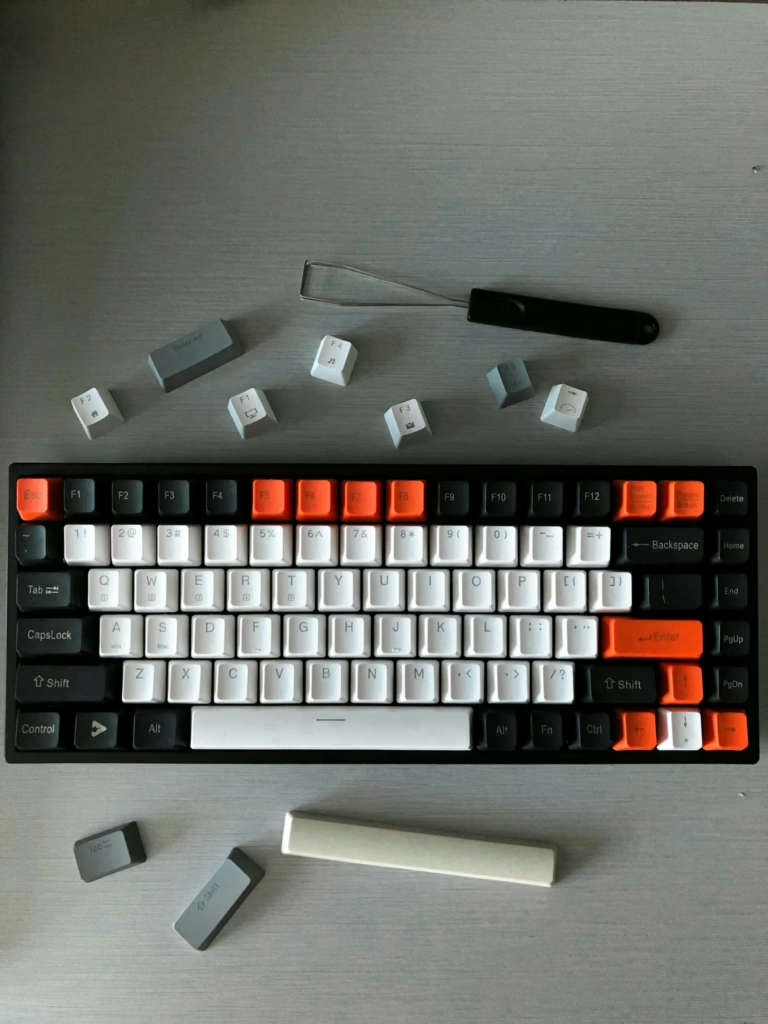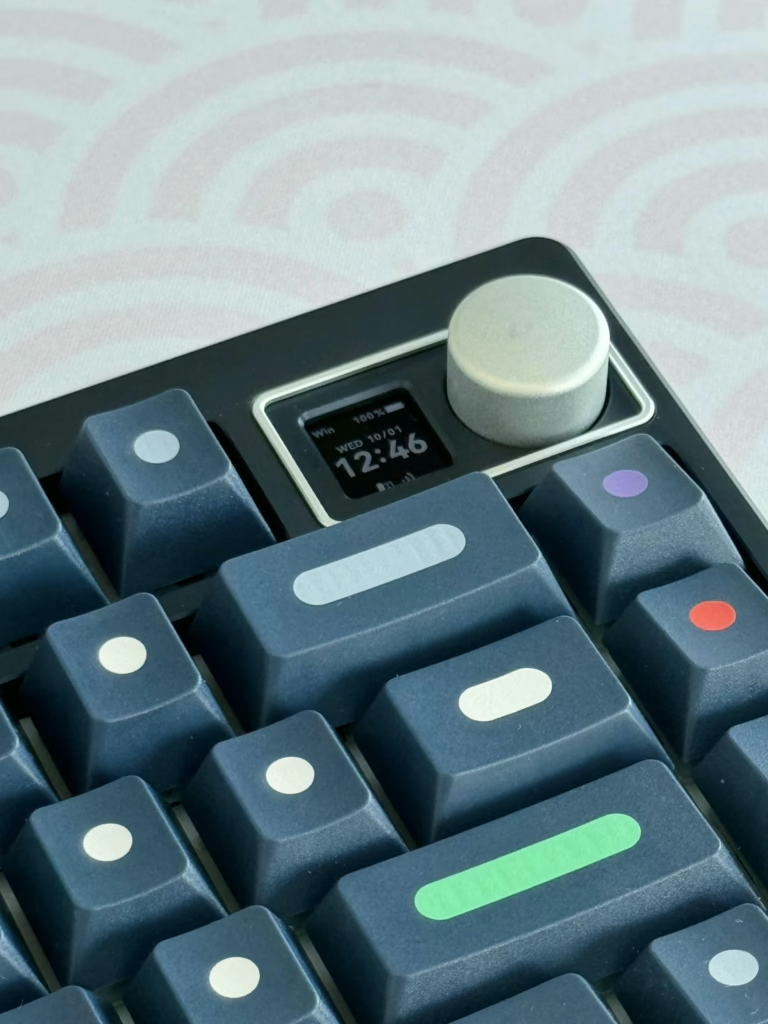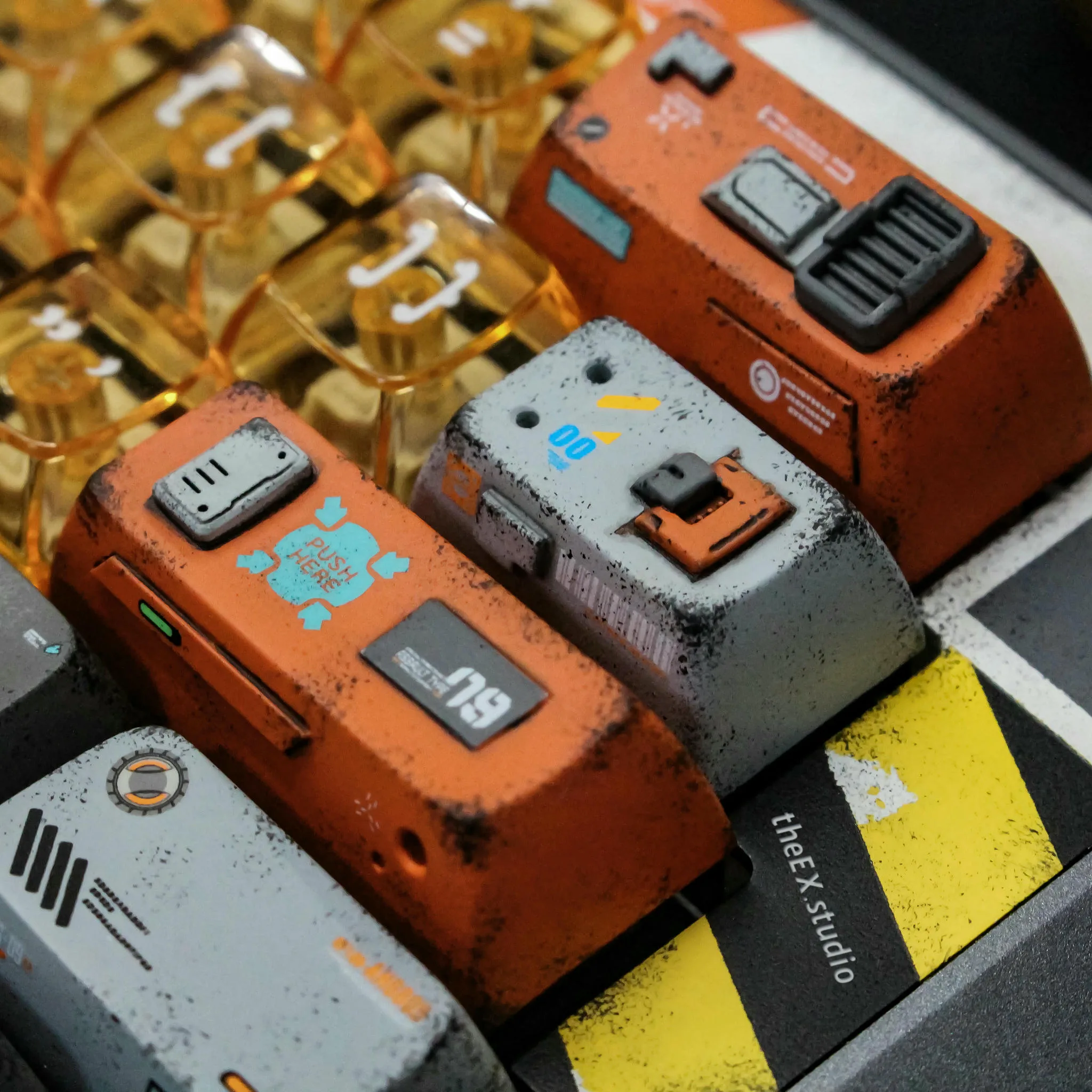Mechanical keyboards have surged in popularity, captivating users with their tactile feedback, satisfying sound, and enhanced typing experience. While pre-built mechanical keyboards offer a significant upgrade from standard membrane keyboards, the world of custom mechanical keyboards unlocks a new level of personalization and performance. This article delves into the intricacies of custom mechanical keyboards, exploring their components, benefits, and the process of building one.
Table of Contents

What is a Custom Mechanical Keyboard?
Unlike mass-produced keyboards, custom mechanical keyboards empower users to handpick every component, tailoring the keyboard to their exact preferences. This includes selecting the switches, keycaps, plate, and even the case material. This level of customization allows for a truly unique typing experience and aesthetic appeal1. Users can personalize the typing feel, remap keys, set key combinations, and more2.
A crucial component of a custom mechanical keyboard is the plate, which plays a vital role in mounting the switches to the PCB (printed circuit board). The plate provides stability and support for the switches, ensuring they are securely fastened and aligned correctly3.
Why Choose a Custom Mechanical Keyboard?
The allure of custom mechanical keyboards lies in the unparalleled control they offer:
- Personalized Typing Experience: Each keystroke is actuated through mechanical switches that provide distinct tactile and auditory feedback, enhancing comfort and satisfaction4. You can choose the type of switches you want, each providing a unique feel and sound1.
- Enhanced Productivity: Programmable keys, macros, and rotary encoders streamline tasks like typing emails, writing code, or editing media4.
- Unique Aesthetics: From vibrant keycap colors and materials to the keyboard’s case and layout, every detail can be customized to match your style and desk setup.
- Superior Build Quality: Custom keyboards often feature high-quality materials and construction, ensuring durability and longevity. This is in contrast to many big brand keyboards, which may be overpriced and offer lower build quality compared to custom builds5.
- Community and Hobby: Building a custom mechanical keyboard can be a rewarding hobby, with a vibrant online community offering support, resources, and inspiration6.
Types of Mechanical Keyboard Switches
Mechanical keyboard switches are the heart of the typing experience. They determine the feel, sound, and responsiveness of each keystroke. The three primary types of switches are:
- Linear Switches: These switches offer a smooth and consistent keypress without any tactile bump or click. They are popular among gamers for their speed and responsiveness7. Linear switches are often preferred for gaming due to their smooth and consistent actuation, allowing for rapid keystrokes and precise control. Examples include Cherry MX Red, Gateron Red, and Kailh Speed Silver.
- Tactile Switches: Tactile switches provide a noticeable bump when activated, offering feedback without the auditory click of clicky switches. They are favored by typists who appreciate the confirmation of a keypress7. Tactile switches are often favored for typing as the tactile bump provides a clear indication of actuation, improving accuracy and typing feel. Popular tactile switches include Cherry MX Brown, Gateron Brown, and Zealios V2.
- Clicky Switches: Clicky switches combine the tactile bump with an audible “click” sound. They offer the most pronounced feedback and are preferred by those who enjoy the classic typewriter feel7. Cherry MX Blue and Kailh BOX White are common examples of clicky switches.
When choosing switches, consider factors like actuation force (the amount of pressure required to register a keypress), travel distance (how far the key travels before bottoming out), and overall sound profile10. While linear switches may result in bottoming out for some users, it’s not always the case, and many people type lightly without bottoming out.
Types of Keycaps
Keycaps are the plastic covers that sit atop the mechanical switches. They come in various materials, profiles, and designs, allowing for extensive customization.
Keycap Materials
The two most common keycap materials are:
- ABS (Acrylonitrile Butadiene Styrene): ABS is a cost-effective and widely used material known for its smooth texture and vibrant color options. However, it is prone to shine and wear over time11.
- PBT (Polybutylene Terephthalate): PBT is a more durable and resistant material that retains its texture and color for longer. It offers a more textured feel and is less susceptible to shine11. PBT keycaps are generally considered higher quality than ABS14. PBT keycaps often produce a deeper sound compared to ABS keycaps due to their higher density16.
Other materials like POM and resin are also used for keycaps, offering unique properties and aesthetics12.

Keycap Profiles
Keycap profiles refer to the shape and height of the keycaps. Different profiles offer varying levels of comfort and aesthetics, catering to different preferences and typing styles17. Some popular profiles include:
- OEM: The standard profile found on most pre-built keyboards18.
- Cherry: Similar to OEM but slightly shorter18.
- SA: Tall and sculpted with a spherical top18.
- DSA: Uniform spherical top for all keys19.
Keyboard Layouts
Keyboard layouts dictate the arrangement of keys. The history of keyboard layouts is intertwined with the development of the typewriter, with layouts like QWERTY designed to prevent jamming by separating commonly used keys20. Common layouts include:
- Full-size: Includes all standard keys, including the number pad, function keys, and navigation cluster21.
- Tenkeyless (TKL): A compact layout that omits the number pad22.
- 60%: A minimalist layout that retains only the alphanumeric keys and essential modifiers22.
Choosing a layout depends on your space requirements, typing habits, and desired functionality. Beyond these common layouts, the keyboard community has developed various specialized formats to further meet the specific needs of typists, each with its own character and layout23.
To better illustrate the differences between these layouts, here’s a table summarizing their key features:
| Layout | Description | Advantages | Disadvantages |
|---|---|---|---|
| Full-size | Includes all standard keys, including the number pad, function keys, and navigation cluster. | Offers all functionality, familiar layout. | Can be large and take up significant desk space. |
| Tenkeyless (TKL) | Omits the number pad while retaining the function keys and navigation cluster. | More compact than full-size, still offers most functionality. | May lack the number pad for those who use it frequently. |
| 60% | Retains only the alphanumeric keys and essential modifiers. | Very compact, ideal for limited desk space. | Requires function layers to access some keys, may have a steeper learning curve. |
Keyboard Plates and Mounting Styles
The keyboard plate not only mounts the switches to the PCB but also influences the overall typing feel and sound of the keyboard. Different plate mounting styles affect the flex and rigidity of the board, resulting in varying levels of feedback and sound24. Two common mounting styles are:
- Tray-mounted: The most basic and commonly used method, where the plate and PCB are secured to the case with standoffs.
- Gasket-mounted: Uses a rubber gasket to isolate the plate and PCB from direct contact with the case, resulting in a softer and quieter typing experience.
Popular Keyboard Brands and Offerings
The custom mechanical keyboard market boasts a wide array of brands, each with its own unique offerings. Some notable brands include:
- Keychron: Known for its high-quality, affordable keyboards with features like hot-swappable switches and Mac compatibility. Keychron offers a range of keyboards, from the budget-friendly V series to the premium Q series, catering to different needs and preferences25.
- Corsair: Offers a range of gaming-focused keyboards with advanced features and customization options. Corsair keyboards often feature RGB lighting, dedicated macro keys, and high polling rates for responsive gaming performance27.
- Asus: Produces high-end gaming keyboards with innovative features and enthusiast-grade components. Asus keyboards like the ROG Azoth series push the boundaries of custom keyboard design with features like OLED displays and gasket-mounted plates28.
- Ducky: Renowned for its well-built keyboards with a focus on quality and aesthetics. Ducky keyboards are known for their minimalist designs, durable construction, and use of high-quality keycaps29.
- Drop: Collaborates with community designers to create unique and premium keyboards. Drop offers a curated selection of keyboards with unique designs, layouts, and features, often in limited-edition group buys27.
Mechanical Keyboard Group Buys
Group buys are a popular way to acquire custom mechanical keyboards, especially those with limited-edition designs or unique features. In a group buy, a vendor or designer gathers interest and pre-orders for a keyboard before production begins. This allows for smaller production runs and more specialized designs that might not be feasible for mass production30.
Group buys often offer lower prices compared to retail releases, as the vendor can reduce costs by producing a specific quantity based on pre-orders. However, group buys typically involve longer lead times, as production and shipping can take several months.
How to Build a Custom Mechanical Keyboard
Building a custom mechanical keyboard can be a rewarding experience. Here’s a general overview of the process:
- Gather the necessary tools and components: This includes a keyboard case, PCB (printed circuit board), plate, switches, stabilizers, keycaps, and tools like a switch puller, keycap puller, and screwdriver33.
- Test the PCB: Ensure the PCB is functioning correctly before assembling the keyboard. This can be done by connecting the PCB to your computer and using a key testing software like VIA to check if each key registers correctly33.
- Assemble the keyboard: Install the stabilizers, switches, and plate onto the PCB. Stabilizers are used for larger keys like the space bar and shift keys to prevent wobble and ensure smooth keystrokes. Switches are then inserted into the plate and PCB, and the plate is secured to the PCB34.
- Solder the switches (if necessary): If using a solderable PCB, solder the switches to the PCB. Solderable PCBs require soldering each switch to the board, while hot-swappable PCBs allow for easy switch installation and removal without soldering3.
- Install the PCB and plate into the case: Secure the assembled components within the keyboard case. This may involve screws, standoffs, or a gasket mounting system depending on the keyboard design34.
- Add keycaps: Place the keycaps onto the switches. Keycaps come in various profiles and designs, allowing for personalization of the keyboard’s aesthetics34.
- Test and fine-tune: Test the keyboard for functionality and make any necessary adjustments. This includes testing all keys, checking for any inconsistencies, and adjusting the keyboard’s settings if needed.
Conclusion
Custom mechanical keyboards offer a unique blend of personalization, performance, and aesthetics. By understanding the various components and the building process, you can create a keyboard that perfectly suits your needs and preferences. Whether you’re a seasoned enthusiast or a curious beginner, the world of custom mechanical keyboards invites you to explore a new dimension of typing and technology.
The ability to choose every aspect of the keyboard, from the switches to the keycaps and layout, allows for a truly personalized typing experience. This level of customization can enhance productivity, comfort, and enjoyment while typing. Furthermore, the use of high-quality materials and construction in custom keyboards ensures durability and longevity, making them a worthwhile investment.
When choosing components for your custom keyboard, consider factors such as your typing style, preferred switch type, keycap material and profile, and desired layout. The vibrant online community and resources available make it easier than ever to research and learn about different options and find the perfect combination for your needs.
Building a custom mechanical keyboard can be a rewarding hobby in itself, offering a sense of accomplishment and satisfaction. The process can be as simple or complex as you desire, with options for both beginners and experienced builders.
Overall, custom mechanical keyboards provide a unique and fulfilling experience for those seeking a higher level of control and personalization in their typing experience. By delving into this world, you can discover a new appreciation for the art and technology of keyboards.
Works cited
1. What’s the deal with Custom Mechanical Keyboards, are they, accessed on December 12, 2024, https://www.minimaldesksetups.com/whats-the-deal-with-custom-mechanical-keyboards-are-they-worth-the-hype/
2. keychron.com.au, accessed on December 12, 2024, https://keychron.com.au/blogs/news/how-to-choose-a-custom-mechanical-keyboard#:~:text=People%20can%20easily%20make%20any,%E2%80%A2
3. Building Custom Mechanical Keyboards: A Guide – Kinetic Labs, accessed on December 12, 2024, https://kineticlabs.com/blog/beginners-guide-to-custom-mechanical-keyboards
4. Why You Should Consider a Custom Mechanical Keyboard | Dangkeebs, accessed on December 12, 2024, https://dangkeebs.com/blogs/blogs-guides/why-you-should-consider-a-custom-mechanical-keyboard
5. Mechanical keyboard recommendations (wired only) and no not logitech – Reddit, accessed on December 12, 2024, https://www.reddit.com/r/buildapc/comments/102ektu/mechanical_keyboard_recommendations_wired_only/
6. Just my type! A beginner’s guide to building a custom mechanical keyboard – KHstats, accessed on December 12, 2024, https://www.khstats.com/blog/keyboard/
7. Keyboard Switch Types: Linear vs Tactile vs Clicky | CORSAIR, accessed on December 12, 2024, https://www.corsair.com/us/en/explorer/gamer/keyboards/key-switch-types-101/
8. Choosing Between Linear, Tactile, and Clicky Switches – Kinetic Labs, accessed on December 12, 2024, https://kineticlabs.com/blog/choosing-between-linear-tactile-clicky-switches
9. Switch Types – Mechanical Keyboard, accessed on December 12, 2024, https://www.mechanical-keyboard.org/switch-types/
10. Types of Keyboard Switches: How to Find the Perfect Keystroke – HHKB, accessed on December 12, 2024, https://hhkeyboard.us/blog/mechanical-keyboard-switch-types
11. A Guide to Keycap Profiles and Materials – Switch and Click, accessed on December 12, 2024, https://switchandclick.com/ultimate-guide-to-picking-a-keycap-set-for-your-mechanical-keyboard/
12. Guide to Keycap Types: Materials, Profiles, and More – Hirosart, accessed on December 12, 2024, https://hirosarts.com/blog/different-types-of-keycaps-guide/
13. ABS vs. PBT Keycaps: Debunking the Myth – Dygma, accessed on December 12, 2024, https://dygma.com/blogs/stories/abs-vs-pbt-keycaps-debunking-the-myth
14. ABS vs PBT : r/MechanicalKeyboards – Reddit, accessed on December 12, 2024, https://www.reddit.com/r/MechanicalKeyboards/comments/7dg86b/abs_vs_pbt/
15. ABS vs PBT keycaps: Which is better? – Corsair, accessed on December 12, 2024, https://www.corsair.com/us/en/explorer/gamer/keyboards/abs-vs-pbt-keycaps/
16. For anyone wondering why PBT sounds “better” than ABS, here’s my attempt to explain why: : r/MechanicalKeyboards – Reddit, accessed on December 12, 2024, https://www.reddit.com/r/MechanicalKeyboards/comments/10z3l73/for_anyone_wondering_why_pbt_sounds_better_than/
17. 2023 Keyboard Building Guide. : r/MechanicalKeyboards – Reddit, accessed on December 12, 2024, https://www.reddit.com/r/MechanicalKeyboards/comments/116nw2e/2023_keyboard_building_guide/
18. The Ultimate Guide to Keycaps: Material, Profile, and Beyond – Redragonshop, accessed on December 12, 2024, https://redragonshop.com/blogs/community/the-ultimate-guide-to-keycaps-material-profile-and-beyond
19. Keycaps – Keyboard University, accessed on December 12, 2024, https://www.keyboard.university/100-courses/keycaps-101-ydy8j
20. Keyboard layout – Wikipedia, accessed on December 12, 2024, https://en.wikipedia.org/wiki/Keyboard_layout
21. Keyboard Sizes & Layouts Explained: Which is best for you? – Corsair, accessed on December 12, 2024, https://www.corsair.com/us/en/explorer/gamer/keyboards/keyboard-sizes-explained/
22. Full-size, TKL, 60% and more: a guide to mechanical keyboard sizes, accessed on December 12, 2024, https://www.thekeyboardco.com/blog/index.php/2017/08/full-size-tkl-60-and-more-a-guide-to-mechanical-keyboard-sizes/
23. Keyboard Sizes & Layouts, accessed on December 12, 2024, https://www.keyboard.university/100-courses/keyboard-sizes-layouts-gdeby
24. A complete BEGINNER guide to the world of Mechanical Keyboards : r/MechanicalKeyboards – Reddit, accessed on December 12, 2024, https://www.reddit.com/r/MechanicalKeyboards/comments/hlf0ql/a_complete_beginner_guide_to_the_world_of/
25. Which mechanical keyboard to do you swear is the best keyboard you have ever owned? : r/mac – Reddit, accessed on December 12, 2024, https://www.reddit.com/r/mac/comments/16cd18h/which_mechanical_keyboard_to_do_you_swear_is_the/
26. The Best Custom Mechanical Keyboards [2024] – Switch and Click, accessed on December 12, 2024, https://switchandclick.com/the-best-custom-mechanical-keyboards/
27. Best mechanical keyboard 2024: 15 picks for gaming, typing and coding | Eurogamer.net, accessed on December 12, 2024, https://www.eurogamer.net/digitalfoundry-best-mechanical-keyboard-for-gaming-typing-coding-7008
28. Best Gaming Keyboards 2024: Full-size, TKL, Mini, and More | Tom’s Hardware, accessed on December 12, 2024, https://www.tomshardware.com/peripherals/gaming-keyboards/best-gaming-keyboards
29. Best gaming keyboards in 2024: the fastest, smoothest and loveliest keyboards I’ve tested, accessed on December 12, 2024, https://www.pcgamer.com/best-gaming-keyboard/
30. Group buy – KBDfans® Mechanical Keyboards Store, accessed on December 12, 2024, https://kbdfans.com/collections/group-buy
31. MechGroupBuys, accessed on December 12, 2024, http://www.mechgroupbuys.com/
32. Keyboard and Keycaps Group Buys & Pre-Orders – KeebFinder, accessed on December 12, 2024, https://keeb-finder.com/group-buys
33. How to Build a Custom Keyboard – A Simple Guide – alexotos, accessed on December 12, 2024, https://www.alexotos.com/how-to-build-a-mechanical-keyboard/
34. How to Build a Custom Mechanical Keyboard: An Easy Guide | Switch and Click, accessed on December 12, 2024, https://switchandclick.com/how-to-build-a-keyboard/
35. How to Build a Mechanical Keyboard – mod musings, accessed on December 12, 2024, https://www.modmusings.com/how-to-build-a-mechanical-keyboard

